 |
part3d
|
Important Note!
part3d is no longer being supported, as it has been superceded by an arbitrary-dimensional version called Part-ND. Please see that page for the most recent version of the code. Part-ND will still perform all of the computations seen on this page.
Introduction
part3d is a stand-alone particle system program written in ANSI C
mostly for my own amusement. It utilizes an octree system for heirarchical space
subdivision and can simulate a variety of forces and boundary conditions.
There is an input file that is fairly self-explanatory, but there are no
guides to help the user choose appropriate parameters for the various
constants. Trial and error was how I made it this far. The strand constants
are especially difficult to choose. Anyways, on with the page.
Files
You can download the code here: part3d_v1.1.tar.gz.
This is version 1.1, which corrects version 0.9's bug that created incorrect
particle force results, and some bugs in 1.0, too. In addition to bug fixes,
there are a few more enhancements.
Features
So far, part3d has the following features:
- Automatic and adaptive octree space subdivision allowing O(NlogN) long-range force computations
- N-body gravitational forces (Barnes and Hut opening criterion) with delta-smoothing (Krasny's delta parameter)
- Hard-sphere contact forces, with contact-axis and contact-plane damping
- Constant-vector gravitation force
- Strand-connectivity forces, compression/tension and bending
- Hard or open boundaries
- 2-d or 3-d density field construction
- Raw and Radiance output for particle locations
- png, gif, pgm output for particle locations and density field
- Time-saving check that runs many more contact time steps than
gravitational time steps
Future versions of part3d may address the following needs:
- Arbitrary number of dimensions
- Better controls on stability (currently uses a 1st order Euler forward integrator)
- Adaptive time step
- Rotations in N-space caused by contact friction
- Setting for molecular (r^-6 or r^-12) forces
- Spring-like attraction forces
- Electrodynamic forces
- Periodic boundaries
- Read and write a raw binary file
Examples
But, despite all that, the program is capable of making some silly little
animations, which you can click upon to view:
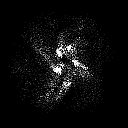
|
20,000 particles in a galaxy-forming gravitation simulation;
animation is a 564 KB aGIF
|
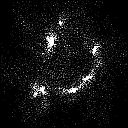
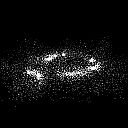
|
32,000 particles in a galaxy-forming gravitation simulation;
animations are 2.5 MB and 9.4 MB MPEGs
|
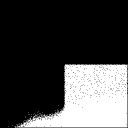

|
100,000 particles falling from initially loosely-placed positions;
animations are 256 KB aGIF and 960 KB MPEG
|
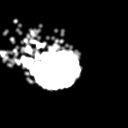
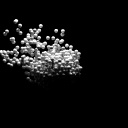
|
A gravitationally-clumped group of 1000 particles being hit by a single particle
with a high density (10 times) and at a very high velocity (10 times escape
velocity), extremely high damping case
|

|
Same as above, high damping
|


|
58 particles in a simulation of a computational strand;
animations are 48 KB aGIF and 250 KB MPEG
|

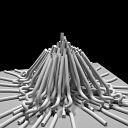
|
64 strand simulation in a strange initial formation;
animations are 100 KB aGIF and 533 KB MPEG
|
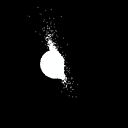
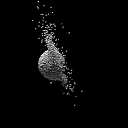
|
A 1000-particle moon impacting a 10000-particle planet;
animations are 230 KB and 750 KB MPEG-1
|
Programming notes
It isn't very difficult to write a computer code to perform these calculations.
The only real complexity is in creating a method to quickly calculate the forces
on one particle from all of the other particles. Here is the simple method:
First, create a data structure for your particles. Feel free to include
any rendering parameters you like, because they won't affect the simulation.
Include a three-vector for position and velocity: x[3], u[3], and
floats for mass and radius. Note that the code is easier to write if
you give all of your particles the same radius.
Second, you need to write a routine to march through your particles and
find the forces or accelerations on each one. Remember, the acceleration
is just the force divided by the particle's mass, so one is as good as the
other. This subroutine is where you include forces due to particle gravity (
F = G * m1 * m2 / d^2), universal gravity (F = mg),
particle contact (F = -k * penetration), and others.
Once you determine the accelerations on all of the particles, multiply them
by the duration of the time step, and add them to the velocities. Update the
positions in a similar manner.
Keep in mind that the naive approach of calculating forces (nested iteration
through the complete particle lists) produces a method that is of order N-squared,
or a doubling of the number of particles makes the code run four times slower.
A good method to use to get around this poor scaling is called octree space
subdivision. I won't go into the details on this page, but you should be
able to find many resources on the web describing the technique. The essence of
it is that you clump particles together as one virtual mass when computing
the effect of that clump of particles on a particle or clump of particles far
away. part3d uses a method that does this.
Revision history
References
J.E. Barnes and P. Hut, A heirarchical O(N log N) force calculations algorithm,
Nature 324, 446 (1986)
Mark Stock, PhD Candidate, University of Michigan, Ann Arbor
Page last modified 2005-02-09

